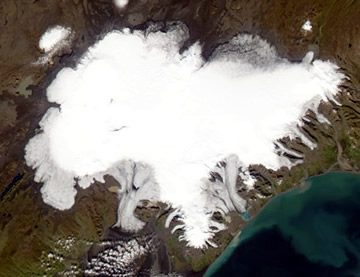Within the last 1.6 million years the Earth has experienced an ice age during which almost one third of the land surface - about 30,000,000 sq km - was covered by ice.
Today the area of ice-covered land has dwindled to 15,600,000 sq km, and continental ice sheets, such as those that were widespread during the last ice age, cover only Greenland and Antarctica.
Smaller ice sheets, known as ice caps, occur in such northern land-masses as Iceland, Spitsbergen and the Canadian Islands.
Valley glaciers that flow out over a plain and coalesce with others to form a broad sheet of ice are called piedmont glaciers; the classic examples of these are found along the southern coast of Alaska.
Ice Movement
 In very cold latitudes there is no summer thaw, and the snow that falls in winter is covered and compressed by snow in subsequent falls. The compressed snow eventually becomes glacier ice three or four kilometers thick.
In very cold latitudes there is no summer thaw, and the snow that falls in winter is covered and compressed by snow in subsequent falls. The compressed snow eventually becomes glacier ice three or four kilometers thick.
The great pressure that builds up underneath the ice makes the ice crystals slide over each other and, because the pressure lowers the melting point of the ice, water is released which lubricates the mass. In addition, glacier ice under pressure can deform elastically like putty. As a result the ice sheet moves outwards away from the build-up of pressure at the center.
In Greenland the movement may be as great as 20m per day, whereas in Antarctica it may only be a meter per year. The bottom layers of the ice move and are deformed, but the top layers remain rigid and are carried along by them, cracking and splitting as they move.
The weight of a continental ice sheet depresses the land beneath it, so that a large percentage of the land surface of Greenland and Antarctica is below sea level. If these ice sheets were to melt, the level of the land below them would rise due to isostasy, as is happening in the areas of the Baltic Sea where the land is still recovering its isostatic balance after having lost the continental ice sheets that covered it during the last ice age.
The restoration of balance does not just involve a simple raising of the land level; before this occurs the melting ice increases the volume of water in the oceans and raises the sea level at the same time.
When an ice sheet passes over or through a mountain range and descends to a lower altitude, as they do in Iceland and the Canadian Islands, it squeezes through the passes and collects between the mountains in the form of lobes that may then become valley glaciers.
The various layers in an ice sheet can be detected by echo sounding, in which pulses of radio waves are sent down into the ice and the resulting echoes analyzed. Reflections from different layers may come from thin layers of dirt, which are probably deposits of volcanic ash that may have periodically drifted into and fallen on the area.
Ice Ages
The Earth has had a number of ice ages. The area covered by them can be mapped by the distribution of rocks, called tillites, which consist of the same type of material found in glacial deposition.
At least three ice ages are known to have occurred in Precambrian times and one in the Upper Ordovician or Lower Silurian period - 430 million years ago - evidence of which has been found in South Africa.
A particularly important ice age occurred in Carboniferous and Permian times - 280 million years ago - and the evidence for this has been found in South America, central and southern Africa, India and Australia. It therefore provides substance for the theory of continental drift and the break-up of Gondwanaland - the great southern continent that existed then.
The most recent ice age was during the Pleistocene era. It began 1,600,000 years ago and ended a mere 11,000 years ago. It consisted of about 18 different advances and retreats of the ice sheets, each one separated by a warm interglacial period during which the climate in the temperate latitudes was at times warmer than it is now.
It is possible that the glacial advances are not over yet and that we are experiencing another interglacial period before the advance of the next ice sheet.
Ice Age Creation
Many theories have been proposed. It has been suggested that the distribution of continental masses may be responsible, for example by preventing the warm oceanic water from reaching the poles. Or the albedo of ice sheets reflects a high percentage of solar radiation and so reduces temperatures sufficiently to affect the world climate. Or there may be fluctuations in the proportion of carbon dioxide or dust particles in the atmosphere; a reduction in carbon dioxide or an increase in dust would allow more heat to be lost from the Earth and so result in lower temperatures.
Others suggest that the reason must be found in space, such as in a fluctuation of the Sun's energy output or the presence of a cloud of dust between the Earth and the Sun.